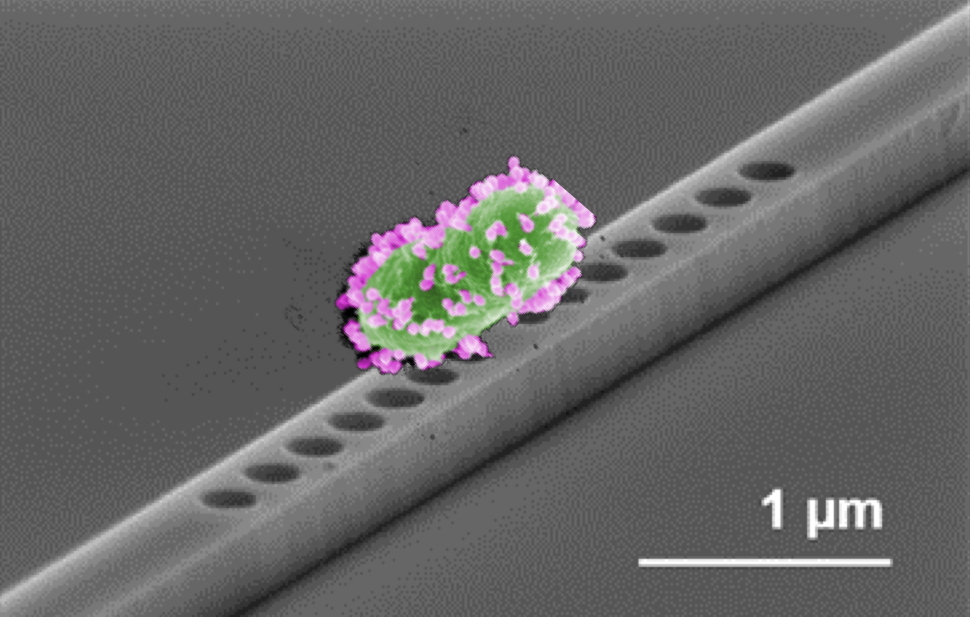Bacteria are essential to humans. For instance, they participate to food digestion through the intestinal microbiota. Some are pathogenic and must of course stay outside the human body, a function provided primarily by the skin. In case of infection by inhalation/ingestion or by wound, taking an antibiotic was for a long time the absolute remedy. However, recent studies show that due to excessive use of antibiotics, a number of bacteria have gradually mutated and become resistant to antibiotics. Current WHO projections even envisage that this could become one of the leading causes of death by 2050, with several million non-curable infections per year. In this context, knowing how to identify a bacterium or test its reaction to a stress such as that caused by an antibiotic, could make it possible to greatly limit the far too widespread use of antibiotics. This could therefore contribute to reduce the dramatic phenomenon of bacterial resistance.
Building upon their knowledge in the field of nanophotonics, the IRIG researchers [
collaboration] have imagined being able to use light to capture a bacterium on a silicon chip. It should be remembered that a force-like effect of the light, called radiation pressure, was first identified by Arthur Ashkin in the early 1970s, when he attempted to trap atoms with lasers. This led him, some fifteen years later, to propose the concept of "optical tweezers" and thus the idea that one could manipulate micro-objects (dielectric spheres of micrometric size) trapped at the waist (
i.e. the narrowest point of the beam) of a tightly focused laser by the so-called gradient force effect. The discovery of this principle earned him the award of the Nobel Prize in Physics in 2018.
In their approach, the consortium's researchers took advantage of their ability to localize light within a microstructure fabricated on a silicon chip. It is indeed a kind of “light box”, in scientific terms an optical nanocavity, in which the light is localized, somehow bouncing between its walls. They then observed that once trapped by the light from the nanocavity, the bacteria interacted with it by modulating the resonance frequency of the nanocavity. Everything then happens as if, like a tuning fork, the sound emitted, here the resonance frequency of the cavity, was modified by the environment surrounding the tuning fork. This gave rise to the idea for researchers to try to test, or determine, the state of a bacterium through its interaction with light within the optical trap provided by the device.
This is actually the demonstration they have just recently made and which was the subject of a publication in the
Small journal. The researchers successively optically trapped bacteria which they subjected to an external stress, carried out for the experiment by immersion in a bath of increasing temperature. For each trapping, they observed the interaction of the bacteria with the optical nanocavities and were thus able to determine the threshold of non-viability, which could be described as the death of these bacteria, with an almost instantaneous response time. This amounts to saying that as soon as the bacterium is within the optical trap, ones know its “healthy” state. This instantaneous reading is of fundamental interest because it becomes therefore no longer necessary, as is the case in current bacteriological analyses, to wait 1 to 2 days for the bacteria sampled to develop on a culture dish in order to be able to test their sensitivity to an antibiotic.
The next step on the agenda is to go from heat stress to that suffered in the presence of an antibiotic, an experiment on which the researchers are currently working. They also aim to show that the same approach could be applied to the interaction of a bacteriophage (a bacterial-destroying virus) with a bacterium, thus allowing a wider and easier use of the latter when no more antibiotics have an effect.

Representation of a bacterium trapped on an optical nanocavity. Credit CEA
Collaboration with the Microelectronics Technologies Laboratory (LTM, CNRS) and the Imaging Systems for Life Laboratory (LSIV)of the Technologies for Healthcare and Biology Division (DTBS) at the Electronics and Information Technology Laboratory of CEA-Grenoble (CEA-Leti).